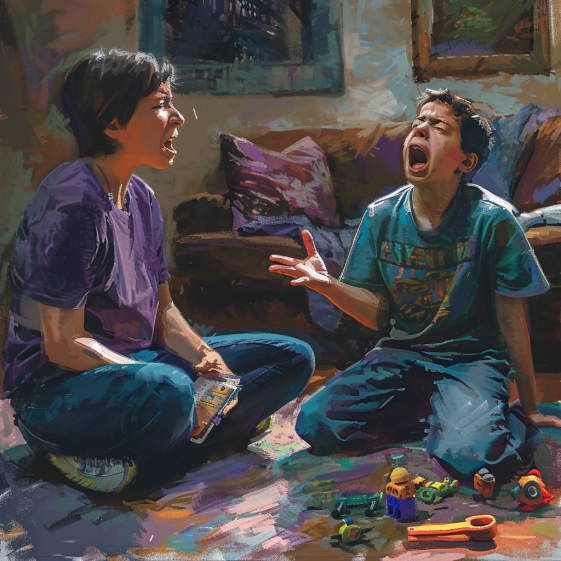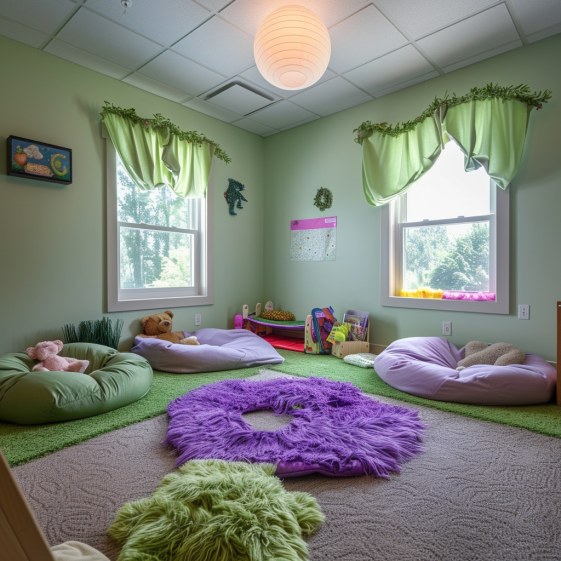Handling aggression in autistic children can feel overwhelming and honestly, heartbreaking. You might find yourself in tears, questioning every parenting decision you’ve ever made, and wondering if you’ll ever really get through to your child. These moments can be loud, chaotic, and scary — for you and for them. The good news? There are reasons behind the behavior, and there are ways to manage it and de-escalate it without feeling like you’re just surviving minute to minute.
I’ve been on this journey for 11 years. I’ve cried more tears than I can count. I’ve screamed into so many pillows. I know how isolating it feels, and I also know this: you are not alone.
Let’s walk through what can cause aggressive behavior in autistic children and what you, as the parent in the middle of it, can actually do.
Understanding the Triggers
Before jumping into possible solutions, it’s important to understand the “why.” Aggression in autistic children is almost never random. It’s usually coming from overwhelm, frustration, pain, or a total loss of control in a situation they can’t regulate.
Some common triggers include:
- Sensory overload (noise, lights, textures, smells, crowds)
- Changes in routine or unexpected transitions
- Communication barriers (can’t say what they need)
- Physical discomfort (pain, hunger, fatigue, illness)
- Demands that feel unfair or too hard in that moment
One extremely helpful thing you can do as a parent is track patterns. Keep a simple log of when aggression happens — time of day, location, what happened right before, how your child reacted, how long it lasted. Over time, you’ll start to see repeat situations and repeat triggers. That gives you power. Once you know the pattern, you can sometimes prevent the meltdown before it even starts.

Disclaimer: The content of this article is for educational purposes only and should not be taken as medical advice. Please discuss details about your child with your physician.
Pro Tip: I use the notes app on my phone and jot things down in the moment — what happened, what set him off, how long it lasted, what helped. You do not need a fancy behavior chart unless that helps you. Your phone is fine. AND, those notes are gold in doctor appointments and school meetings.
Communication Challenges and Aggression
A huge piece of aggression in autistic kids comes down to communication. Imagine needing something desperately and not being able to ask for it. Imagine being in pain and no one understanding you. That kind of frustration can turn into hitting, biting, throwing, screaming — because those are ways to send a message when words won’t work.
I get it when people say “just use your words,” but for some autistic kids, that’s not realistic. My son is 11, and he still doesn’t have a fully reliable way to communicate every need. So let’s talk about supports that can actually help.
Visual Aids and Sign Language
For nonverbal kids or limited speakers, visuals can make a massive difference. Picture cards, communication boards, yes/no cards, emotion charts — these tools give your child a way to point to “I’m hungry,” “I need a break,” “I’m mad,” instead of having to act it out physically.
Simple sign language can also help. Even just a few signs (“eat,” “stop,” “hurt,” “bathroom,” “all done”) can lower stress because your child doesn’t have to fight to be understood.
Using Tech to Support Communication
If your child responds well to screens, this can actually be a good thing. There are communication apps for tablets and iPads designed specifically for kids with complex communication needs. These apps let kids tap icons or phrases instead of speaking, which can prevent meltdowns before they start.
In many cases, schools, local organizations, and even insurance may help pay for a communication device or app. My son uses an iPad with a communication app that was provided through school. So if you look up the price and your stomach drops — pause. Financial assistance is possible. Ask the school team, your child’s therapist, or your pediatrician about AAC (Augmentative and Alternative Communication) support.
Consistency and Routine
Children on the spectrum often feel safest when they know what’s coming next. Sudden changes and surprise transitions can trigger panic, which can turn into aggression fast. Building predictable routines gives your child structure and lowers anxiety.
Some ideas:
- Use a visual schedule (pictures of breakfast → school → home → iPad → bath → bedtime)
- Give countdown warnings before transitions (“Five more minutes, then shoes. Two more minutes. One more minute. Time for shoes.”)
- Keep morning and bedtime routines as consistent as possible
Change will still happen. Life is rude like that. Just try not to stack a ton of changes all at once. If there’s even a chance plans might shift (“Grandma might need us to leave the park early to take her to the doctor”), prep your child ahead of time. You’re not promising it will happen, you’re normalizing that it could happen, so they aren’t blindsided if it does.
Creating a Calming Environment
Sensory-Friendly Spaces
Some autistic kids are incredibly sensitive to things most adults barely notice — buzzing lights, certain fabrics, voices talking over each other, background TV noise, even the texture of their own clothes. That constant sensory input builds pressure. Aggression can be the release valve.
Giving your child a safe, sensory-friendly retreat can help. This doesn’t have to be an entire “sensory room.” It can be a corner. It can be their bedroom. Fill that space with calming items they respond well to, like:
- Noise-canceling headphones
- Weighted blankets
- Stuffed animals or chew-safe fidgets
- Soft lighting or blackout curtains
- Crash pad or safe jumping space
- Small indoor trampoline
In my house, we don’t have spare rooms. So all of this lives in my son’s bedroom. That’s his safe place. When he’s overloaded, he’ll go straight there, shut the door, bury himself under his weighted blanket with the lights off, or jump on his trampoline to burn out that extra energy. The point is not “make it Pinterest-pretty.” The point is “give them somewhere to regulate.”
Mindfulness and Regulation Tools

Some kids can learn simple self-regulation skills over time. Think deep breathing, squeezing a stress ball, pushing their hands against a wall, or doing a slow body “check-in” to find where they’re tense. These won’t magically stop every meltdown, but practicing them during calm moments (not during the meltdown) can make them easier to use later when emotions start to spike.
Positive Reinforcement and Behavior Strategies
Reward Systems
Positive reinforcement means: catch the good, not just the hard. If your child tries to use a word, a sign, a button on their device instead of hitting — celebrate it. This doesn’t have to be fancy. You can use a sticker chart, tokens, or a simple “You asked with your iPad, so you get five minutes of (favorite thing).”
We’re teaching: “When you communicate in a way that’s safe, good things happen.” Over time, that message sticks more than “don’t hit.”
Professional Behavioral Therapy
Sometimes, even with all the structure and love in the world, it’s still too big to do alone. There is nothing wrong with getting professional help.
ABA (Applied Behavior Analysis) is one common therapy model that focuses on building communication, emotional regulation, and daily living skills while reducing unsafe behaviors. It uses positive reinforcement to teach safer alternatives. That said — ABA gets mixed reactions in the autism community, and that matters.
ABA is not one-size-fits-all. Some centers are amazing and respectful. Some are not. The key is finding a provider that treats your child like a human being, not a checklist. Ask local autism parent groups which clinics they trust. Ask how breaks are handled. Ask if your child is allowed to stim. You are allowed to say no to a place that doesn’t feel right.
Self-Care for Parents (Yes, You Matter Too)
Here’s the part no one wants to say out loud: being on the receiving end of aggression from your own child hurts. Physically and emotionally. You can love your kid more than life and still feel burned out, angry, guilty, and numb all at once.
If you are running on fumes, you cannot show up the way you want to. You just can’t. And that’s not failure — that’s biology.
Seeking Support
You need people in your corner. Other parents who get it are lifesavers. Local autism parent groups, online communities, support groups in your area — these can give you a place to vent without judgment. You’re allowed to say, “Today was bad,” without following it up with “but I’m blessed.”
Talk to someone. Anyone. You’re allowed to need help.
Professional Help for You
If you’re feeling constantly on edge, anxious, tapped out, or like you’re not yourself anymore, please consider talking to a mental health professional. Therapy for caregivers is not selfish. It’s survival. A good therapist can help you come up with scripts, boundaries, and actual coping strategies so you’re not white-knuckling through every day.
Building a Support Network
Looping in Your Family: Let other family members know what’s going on and how they can support — not just your autistic child, but you. Explain what certain behaviors mean (“He’s not attacking you, he’s overwhelmed”) and what helps calm things down. Siblings, grandparents, and close friends are part of the team whether they realize it or not.
School and Community Resources: Work with your child’s school to make sure they’re supported during the day. Ask about behavior plans, communication tools, quiet spaces, and accommodations. You are allowed to advocate. You are allowed to ask for more.
Empathy, Patience, and Perspective
This is important: your child’s aggression is not personal. It feels personal, especially in the moment. But most of the time, aggression is communication. It is “I can’t tell you what’s wrong, but something is wrong.”
That doesn’t mean you accept unsafe behavior. It means you approach it like a crisis, not a character flaw. You’re not raising a “bad kid.” You’re raising a kid who is asking for help in the only way they can right now.
Celebrate the Small Wins
Progress is not always big and dramatic. Sometimes progress is “he only hit once today instead of five times.” Sometimes it’s “she tried to use her device before throwing the toy.” Sometimes it’s just “he calmed down in ten minutes instead of forty.”
Those are wins. They count. Please let them count.
Final Thoughts
Parenting an autistic child through aggression is emotionally intense, exhausting, and at times isolating — but it is also full of moments of unbelievable love, softness, and connection. You are doing more than most people will ever understand.
You are not alone, mama.
With patience, support, and the right tools in place, it is possible to reduce aggression, build better communication, and create calmer routines. Keep advocating for your child — and please don’t forget to advocate for yourself, too.


Leave a Reply